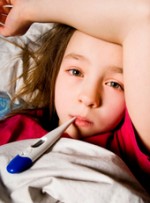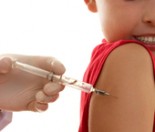We provide information about Scarlet Fever – the causes, signs and symptoms, treatment, risks and complications and advice on how to help your child at home with scarlet fever.
What causes Scarlet fever?
Scarlet fever is a bacterial illness caused by the Group A Streptococcus bacteria, which is carried in the nose and mouth. Scarlet fever presents as tonsillitis accompanied by a scarlet rash.
Early last century scarlet fever often resulted in deadly epidemics, but antibiotic treatment is now used:
- to treat the illness
- to prevent rheumatic fever developing (an inflammatory disease that can cause damage to the joints, skin, brain and especially the heart).
The illness occurs most commonly in children aged 4–8 and by age 10 most kids have developed a natural immunity against the illness. Toddlers (i.e. children under 2) are normally protected by immunity received from their mother.
The incubation period for the disease (the time from exposure to the bacteria through to developing the symptoms) is 2 – 4 days
What are the signs and symptoms of scarlet fever?
- A sore throat, fever, headache followed by a rash 1-2 days later
- Rash often looks like a bad sunburn with tiny bumps that feel like sandpaper
- Rash is itchy
- Rash normally begins on face and neck and the child looks `scarlet’ with a clear unaffected area around mouth
- Rash spreads to chest, back and rest of body. In body creases the rash forms red streaks
- Strawberry tongue – tongue has thick white coating that peels after four or five days giving it a red `strawberry’ appearance
- Tonsils and back of throat may have a white coating or be red, swollen and dotted with yellow specks of pus
- Swollen neck glands
- High temperature and chills
- Headache
- Nausea and vomiting, abdominal pain and loss of appetite
What is the treatment or cure for scarlet fever?
Your child needs to see a doctor – diagnosis is made from the child’s symptoms and also a throat swab.
- Antibiotics are prescribed – with antibiotic treatment the fever improves within 12 – 24 hours and recovery is made in 4 – 5 days, though it may take a few weeks for swollen glands and tonsils to return to normal.
- It is very important your child completes the whole course of antibiotics
Risks and complications of scarlet fever
Rare complications caused by the streptococcus bacteria are nephritis (inflammation of the kidney) and rheumatic fever (inflammation of the joints and heart). If left untreated it can also cause otitis media (middle ear infection), pneumonia, septicaemia (serious blood poisoning), osteomyelitis (a bone infection) and in the worst-case scenario, death.
While scarlet fever was once considered a very serious childhood illness, it is now not regarded any more seriously than any other ‘strep throat’.
In rare cases, scarlet fever may develop from a streptococcal skin infection such as impetigo. If your child has impetigo, scarlet fever can also be spread by touch. People living in crowded conditions are more at risk of the condition.
What can I do for my child with scarlet fever?
- Give your child paracetamol to help with fever and pain (check the appropriate dose for age on the bottle).
- Keep up fluid intake and give soft foods – soups, milkshakes, ice cream, iceblocks
- Keep your child as comfortable as possible in cool cotton clothing.
- It is likely your child’s skin will peel as the rash heals- trim your child’s fingernails when the rash is itchy to avoid secondary skin infections.
- To help ease the itch dab calamine lotion over your child’s skin
- If your child has scarlet fever, keep them away from infants and younger siblings.
- Scarlet fever is contagious and can be spread through sneezing and coughing so keep your child home from school
- Use separate plates, glasses, towels and clothes from the rest of the family
- A warm facecloth used as a compress to the side of the neck may help soothe swollen glands.
Now that you know more about croup, you may want to arm yourself with more expert health advice, see our Common childhood illnesses section.






Yes while searching on internet about scarlet fever i came to this post – My baby is currently infected by strep .Today is day two and doctor had given her azithromycin for 5 days and other medicines to improve her mouth thrush and for fever too
But you know my daughter is vomitting and not eating .. she sometimes also vomits meds what she had taken few minutes back.. i am very worried
But my doctor said that if one has strep A Infection and if there are reoccuring history of strep throat infections then whole family should be treated
Hi Nikhil,
It’s really impossible to help across the internet but I strongly suggest that if you continue to be worried, take your baby back to your doctor. Babies can get worse quite quickly and so if you are worried, it’s best to get someone to check her out.
Rochelle
Hi, my five year old son has scarlet fever and we have found that solarcaine with aloe vera is great for the itchiness. Infact I use it for alot of things such as cuts and grazes, itchy bites etc.
Thanks, Angela.
Hi Ruth I’m really sorry to hear about your scarlet fever, it sounds pretty miserable. I have not had experience of adults with scarlet fever, but I hope you get a response and some great advice. As with all infections, your body is working hard to fight the invaders, so eat easily digestible foods, rest as much as possible and use a soothing lotion on your skin. Aloe vera has been recommended on this site before, for chicken pox? Ask at your pharmacy or health shop what they would recommend. All the best for a speedy recovery Paula, nurse at… Read more »
Hi Paula
I am 52 years old and have recently been diagnosed with
scarlet fever. I am told that this is usually diagnosed in children. Is
there anything I should be wary of since having this condition. I am at
the stage where my skin is peeling and I still have a rash on my body. I
am quite lethargic and am finding it hard to get my energy back. Is
there any other adults out there who have had scarlet fever and what is
the time frame for full recovery?
Thanks
Ruth